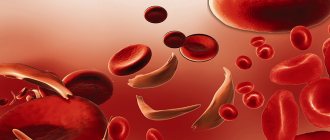Gastrointestinal bleeding is the leakage of blood into the cavity of the stomach and intestines, followed by its release only with feces or with feces and vomiting. It is not an independent disease, but a complication of many – more than a hundred – different pathologies.
Gastrointestinal bleeding (GIB) is a dangerous symptom, indicating that it is urgent to find the cause of the bleeding and eliminate it. Even if a very small amount of blood is released (and there are even situations where the blood is not visible without special tests), this may be the result of a very small, but rapidly growing and extremely malignant tumor.
Note! Gastrointestinal bleeding and internal bleeding are not the same thing. In both cases, the source of bleeding can be the stomach or various parts of the intestine, but with gastrointestinal tract bleeding, blood is released into the cavity of the intestinal tube, and with internal bleeding, into the abdominal cavity. Gastrointestinal bleeding can in some cases be treated conservatively, while internal bleeding (after injury, blunt trauma, etc.) can only be treated surgically.
What is gastrointestinal bleeding?
Gastrointestinal bleeding (GIB) is the leakage of blood from blood vessels damaged by disease into the cavities of the gastrointestinal tract. Gastrointestinal bleeding is a common and serious complication of a wide range of pathologies of the gastrointestinal tract, posing a threat to the health and even life of the patient. The volume of blood loss can reach 3-4 liters, so such bleeding requires emergency medical attention.
In gastroenterology, gastrointestinal bleeding ranks 5th in prevalence after appendicitis, pancreatitis, cholecystitis and strangulated hernia.
The source of bleeding can be any part of the gastrointestinal tract. In this regard, bleeding occurs from the upper gastrointestinal tract (esophagus, stomach, duodenum) and lower gastrointestinal tract (small and large intestine, rectum).
Bleeding from the upper sections accounts for 80-90%, from the lower sections – 10-20% of cases. If we look in more detail, the stomach accounts for 50% of bleeding, the duodenum - 30%, the colon and rectum - 10%, the esophagus - 5% and the small intestine - 1%. With gastric and duodenal ulcers, a complication such as bleeding occurs in 25% of cases.
According to the etiology, ulcerative and non-ulcerative gastrointestinal bleeding is distinguished, according to the nature of the bleeding itself - acute and chronic, according to the clinical picture - obvious and hidden, and according to duration - single and recurrent.
The risk group includes men in the age group 45-60 years. 9% of people taken to surgery by ambulance arrive with gastrointestinal bleeding. The number of its possible causes (diseases and pathological conditions) exceeds 100.
What happens when you lose more than 300 ml of blood
Massive bleeding from the gastrointestinal tract causes the following changes in the body:
- blood volume decreases, while the diameter of the vessels remains the same;
- The blood no longer presses on the walls of the vessels as before, so the arteries can no longer ensure the movement of blood so well - the speed of blood circulation decreases;
- a decrease in the speed of blood flow in the center of the body means too slow movement of blood in the area of capillaries and smaller vessels (microcirculatory bed), the task of which is to provide tissues with oxygen and necessary substances, and to collect waste products from them;
- a slowdown in blood flow in the area of the microvasculature leads to the development of stagnation here (here, anyway, the vessels are small and the speed of blood movement is always low);
- When there is stagnation in the microcirculatory bed, red blood cells stick together in them. If you start treatment at this stage, then in addition to blood transfusions and blood substitutes, you need to administer saline solutions and blood-thinning drugs (heparin). Otherwise, the clots formed in the capillaries will flow en masse into the general channel and may, when collected, clog some larger artery;
- the exchange between clogged blood capillaries and tissues becomes very difficult and may stop altogether. This situation is observed in almost all tissues. The first to suffer is microcirculation in the skin and subcutaneous tissue, then the internal organs gradually “switch off.” The heart and brain work in “economy mode” for a long time, but if blood is lost quickly, or the total volume of blood loss exceeds 2.5 liters, then they too “switch off”;
- Violation of microcirculation in the liver leads to the fact that it ceases to neutralize toxins from the blood and poorly produces blood clotting factors. As a result, the blood becomes liquid and does not clot. This is a very dangerous condition. At this stage, blood transfusion alone is not enough - blood clotting factors must be administered. They are contained in blood plasma (it is ordered at the transfusion station) and in individual preparations.
Causes of stomach bleeding
All gastrointestinal bleeding is divided into four groups:
- Bleeding due to diseases and damage to the gastrointestinal tract (peptic ulcer, diverticula, tumors, hernias, hemorrhoids, helminths, etc.);
- Bleeding due to portal hypertension (hepatitis, cirrhosis of the liver, cicatricial strictures, etc.);
- Bleeding due to vascular damage (esophageal varices, scleroderma, etc.);
- Bleeding due to blood diseases (aplastic anemia, hemophilia, leukemia, thrombocythemia, etc.).
Bleeding due to diseases and damage to the gastrointestinal tract
In the first group, ulcerative and non-ulcerative gastrointestinal tracts are distinguished. Ulcerative pathologies include:
- Stomach ulcer;
- Duodenal ulcer;
- Chronic esophagitis (inflammation of the esophageal mucosa);
- Gastroesophageal reflux disease of the esophagus (develops as a result of systematic spontaneous reflux of stomach contents into the esophagus);
- Erosive hemorrhagic gastritis;
- Nonspecific ulcerative colitis and Crohn's disease (pathologies of the large intestine, similar in symptoms, but having different etiologies).
There are also the following reasons leading to acute gastrointestinal ulcers:
- Medication (long-term use of glucocorticosteroids, salicylates, NSAIDs, etc.);
- Stressful (mechanical injuries, burns, foreign bodies entering the gastrointestinal tract, emotional shock after injuries, operations, etc.);
- Endocrine (Zollinger-Ellison syndrome (release of the biologically active substance gastrin by an adenoma (tumor) of the pancreas) hypofunction of the parathyroid glands);
- Postoperative (previously performed operations on the gastrointestinal tract).
Bleeding of a non-ulcer nature can be caused by:
- Erosion of the gastric mucosa;
- Mallory-Weiss syndrome (rupture of the mucous membrane at the level of the esophagogastric junction with recurrent vomiting);
- Diverticula of the gastrointestinal tract (protrusion of the walls);
- Diaphragmatic hernia;
- Bacterial colitis;
- Hemorrhoids (inflammation and pathological dilation of the rectal veins that form nodes);
- Anal fissures;
- Benign tumors of the gastrointestinal tract (polyps, lipoma, neuroma, etc.);
- Malignant tumors of the gastrointestinal tract (cancer, sarcoma);
- Parasitic intestinal lesions;
- Infectious lesions of the intestines (dysentery, salmonellosis).
Bleeding due to portal hypertension
The cause of gastrointestinal bleeding of the second group can be:
- Chronic hepatitis;
- Cirrhosis of the liver;
- Hepatic vein thrombosis;
- Portal vein thrombosis;
- Compression of the portal vein and its branches by scar tissue or tumor formation.
Bleeding due to vascular damage
The third group includes gastrointestinal bleeding caused by damage to the walls of blood vessels. They are caused by the following diseases:
- Atherosclerosis of blood vessels of internal organs;
- Vascular aneurysms (expansion of the lumen of the vessel with simultaneous thinning of its walls);
- Varicose veins of the esophagus or stomach (often formed as a result of liver dysfunction);
- Systemic lupus erythematosus (an immune disease that affects connective tissue and capillaries;
- Scleroderma (systemic disease causing sclerosis of small capillaries);
- Hemorrhagic vasculitis (inflammation of the walls of blood vessels of internal organs);
- Rendu-Osler disease (congenital vascular anomaly accompanied by the formation of multiple telangiectasia);
- Periarteritis nodosa (damage to the arteries of internal organs);
- Thrombosis and embolism of intestinal mesentery vessels;
- Cardiovascular pathologies (heart failure, septic endocarditis (damage to the heart valves), constrictive pericarditis (inflammation of the pericardial sac), hypertension).
Bleeding due to blood diseases
The fourth group of gastrointestinal bleeding is associated with blood diseases such as:
- Hemophilia and von Willebrand disease are genetically determined bleeding disorders);
- Thrombocytopenia (deficiency of platelets - blood cells responsible for blood clotting);
- Acute and chronic leukemia;
- Hemorrhagic diathesis (thrombasthenia, fibrinolytic purpura, etc. - a tendency to recurrent bleeding and hemorrhage);
- Aplastic anemia (impaired bone marrow hematopoietic function).
Consequently, gastrointestinal bleeding can occur both due to a violation of the integrity of blood vessels (with their ruptures, thrombosis, sclerosis) and due to hemostasis disorders. Often both factors are combined.
With ulcers of the stomach and duodenum, bleeding begins as a result of melting of the vascular wall. This usually occurs during the next exacerbation of a chronic disease. But sometimes there are so-called silent ulcers that do not make themselves known until they bleed.
In infants, intestinal bleeding is often caused by intestinal volvulus. The bleeding with it is quite scanty, the main symptoms are more pronounced: an acute attack of abdominal pain, constipation, non-passage of gas. In children under three years of age, such bleeding is more often caused by abnormalities in intestinal development, the presence of neoplasms, and diaphragmatic hernia. Older children are more likely to have colon polyps: in this case, a little blood is released at the end of a bowel movement.
How to identify the source?
The doctor’s task is to establish not only the source of bleeding, but also to determine the condition of the damaged vessel (continues to bleed, there is a dense blood clot, a relapse is likely). If vomiting of blood or melena occurred in the presence of an ambulance doctor or a hospital, then the fact of bleeding is considered proven.
If this does not happen, then a finger examination of the rectum is performed. Traces of black blood remain on the glove. Hidden bleeding in chronic diseases is determined using a stool test for the Gregersen reaction. To do this, it is necessary to prepare the patient: even brushing your teeth is prohibited.
The most accurate diagnostic method is considered to be esophagogastroduodenoscopy with an endoscope.
Deterioration of the patient's condition, decreased blood pressure, repeated loose stools and vomiting indicate ongoing bleeding. As an objective sign, insertion of a gastric tube and lavage of the stomach to clean water is used. After an hour and a half, blood flows from the probe again. In surgical hospitals, endoscopy specialists are on duty around the clock. The examination is included in the standard of care.
In addition to the source, the endoscopist gives the conclusion: “the bleeding has stopped” - this means that the source is closed by a dense fibrin clot, a recurrence is unlikely during medical procedures, “hemostasis is unstable” - the defect is closed by a loose black clot, a pulsating vessel is less visible, and the threat of re-bleeding remains.
Repeated massive bleeding is characteristic of a deep ulcer along the lesser curvature of the stomach in the projection of the left gastric artery.
Signs and symptoms of stomach bleeding
Common symptoms of gastrointestinal bleeding are:
- Weakness;
- Nausea, vomiting blood;
- Dizziness;
- Pale skin, blue lips and fingertips;
- Changed stool;
- Cold sweat;
- Weak, rapid pulse;
- Decreased blood pressure.
The severity of these symptoms can vary widely: from mild malaise and dizziness to deep fainting and coma, depending on the rate and volume of blood loss. With slow, weak bleeding, their manifestations are insignificant; a slight tachycardia is observed at normal pressure, since partial compensation of blood loss has time to occur.
Gastrointestinal tract symptoms are usually accompanied by signs of the underlying disease. In this case, pain in different parts of the gastrointestinal tract, ascites, and signs of intoxication may be observed.
In case of acute blood loss, short-term fainting is possible due to a sharp drop in pressure. Symptoms of acute bleeding:
- Weakness, drowsiness, severe dizziness;
- Darkening and “floaters” in the eyes;
- Noise in ears;
- Shortness of breath, severe tachycardia;
- Increased sweating;
- Cold feet and hands;
- Weak pulse and low blood pressure.
Symptoms of chronic bleeding are similar to those of anemia:
- Deterioration of general condition, high fatigue, decreased performance;
- Paleness of the skin and mucous membranes;
- Dizziness;
- Presence of glossitis, stomatitis, etc.
The most characteristic symptom of gastrointestinal tract infection is blood in the vomit and stool. Blood in vomit may be present in unchanged form (in case of bleeding from the esophagus in the case of varicose veins and erosions) or in an altered form (in case of stomach and duodenal ulcers, as well as Mallory-Weiss syndrome). In the latter case, the vomit has the color of “coffee grounds”, due to the mixing and interaction of blood with hydrochloric acid of the contents of gastric juice. Blood in vomit is bright red in profuse (massive) bleeding. If bloody vomiting occurs again after 1-2 hours, most likely, bleeding continues, if after 4-5 hours, this is more indicative of re-bleeding. With bleeding from the lower gastrointestinal tract, vomiting is not observed.
In the stool, blood is present unchanged in case of a single blood loss exceeding 100 ml (with bleeding from the lower part of the gastrointestinal tract and with a stomach ulcer). In an altered form, blood is present in the stool during prolonged bleeding. In this case, 4-10 hours after the bleeding began, tarry, dark, almost black stools (melena) appear. If less than 100 ml of blood enters the gastrointestinal tract during the day, visual changes in stool are not noticeable.
If the source of bleeding is in the stomach or small intestine, the blood is usually evenly mixed with the stool; when flowing from the rectum, the blood appears as separate clots on top of the stool. The discharge of scarlet blood indicates the presence of chronic hemorrhoids or anal fissure.
It is necessary to take into account that the stool may have a dark color when eating blueberries, chokeberries, beets, buckwheat porridge, taking activated carbon, iron and bismuth supplements. Also, the cause of tarry stools can be the ingestion of blood during pulmonary or nasal bleeding.
Gastric and duodenal ulcers are characterized by a decrease in ulcer pain during bleeding. If there is heavy bleeding, the stool becomes black (melena) and loose. During bleeding, abdominal muscle tension does not occur and other signs of peritoneal irritation do not appear.
With stomach cancer, along with the typical symptoms of this disease (pain, weight loss, lack of appetite, changes in taste preferences), recurrent, mild bleeding and tarry stools are observed.
With Mallory-Weiss syndrome (rupture of the mucous membrane), profuse vomiting occurs mixed with scarlet unchanged blood. With varicose veins of the esophagus, bleeding and its clinical symptoms develop acutely.
With hemorrhoids and anal fissures, scarlet blood can be released at the time of defecation or after it, as well as during physical stress, and does not mix with feces. Bleeding is accompanied by anal itching, burning, and spasms of the anal sphincter.
With cancer of the rectum and colon, the bleeding is prolonged, not intense, dark blood mixes with the feces, and mucus may be present.
With ulcerative colitis and Crohn's disease, watery bowel movements mixed with blood, mucus and pus are observed. With colitis, false urge to defecate is possible. In Crohn's disease, bleeding is mostly light, but the risk of heavy bleeding is always high.
Profuse gastrointestinal bleeding has four degrees of severity:
- The condition is relatively satisfactory, the patient is conscious, the pressure is normal or slightly reduced (not lower than 100 mm Hg), the pulse is slightly elevated as the blood begins to thicken, the level of hemoglobin and red blood cells is normal.
- The condition is moderate, there is pallor, increased heart rate, cold sweat, blood pressure drops to 80 mm Hg. Art., hemoglobin is up to 50% of normal, blood clotting decreases.
- The condition is serious, there is lethargy, swelling of the face, pressure below 80 mm Hg. Art., pulse above 100 beats. per minute, hemoglobin - 25% of normal.
- Coma and the need for resuscitation measures.
In children
Gastric bleeding in children requires urgent hospitalization. The main causes of this pathology in children are associated with gastric ulcers. A burn can cause gastric bleeding. Chemical or mechanical burn, depending on the exposure factor.
Also in the etiology of this disease in children is a blood disease. It may be a genetic disease. Or an acquired blood pathology. Let's say leukemia or hemorrhagic vasculitis.
What are the main signs of gastric bleeding in children? The main symptoms include vomiting and anemia. Bleeding may be accompanied by:
- dizziness;
- dry mouth;
- increased thirst;
- pallor;
- tachycardia
Newborns may experience prolonged bleeding. Moreover, it is spontaneous, independent of certain factors. What is most dangerous in childhood? Especially during the newborn period.
A common cause of stomach bleeding in children is ulcerative gastritis. Or pathology of the esophagus. With ulcerative gastritis, stress and poor nutrition occur. And this is the most dangerous disease. Requires urgent hospitalization!
go to top
First aid for gastrointestinal bleeding
Any suspicion of gastrointestinal tract infection is an urgent reason to call an ambulance and transport the person to a medical facility on a stretcher.
Before doctors arrive, you need to take the following first aid measures:
- Lay the person on their back, with their legs slightly raised, and ensure complete rest.
- Eliminate food intake and do not allow drinking - this stimulates the activity of the gastrointestinal tract and, as a result, bleeding.
- Place dry ice or any other cold object on the area of suspected bleeding - cold constricts blood vessels. It is better to apply ice for 15-20 minutes with 2-3 minute breaks to prevent frostbite. Additionally, you can swallow small pieces of ice, but in case of stomach bleeding it is better not to risk it.
- You can give 1-2 teaspoons of a 10% solution of calcium chloride or 2-3 crushed tablets of Dicynone.
It is forbidden to give an enema or wash out the stomach. If you faint, you can try to revive yourself with ammonia. If you are unconscious, monitor your pulse and breathing.
Prevention
Ulcerative bleeding can be prevented if gastritis and all recommendations of the attending physician are followed. The modern lifestyle and diet have a negative impact on the condition of the digestive tract. Ulcerative lesions do not develop in one day, it is a long process that begins with a slight change in the structure of the stomach wall, which progresses under the influence of negative factors.
Complications of gastrointestinal bleeding
Gastrointestinal bleeding can lead to dangerous complications such as:
- hemorrhagic shock (as a consequence of heavy blood loss);
- acute anemia;
- acute renal failure;
- multiple organ failure (stress response of the body, consisting in the cumulative failure of several functional systems).
Untimely hospitalization and attempts at self-medication can lead to death.
Exodus
Stomach bleeding can end unfavorably. The patient may fall into a comatose state. And this is directly related to the intensity of bleeding and the timeliness of treatment.
Only with timely treatment are positive trends observed. Until recovery. If the patient begins treatment on time, the outcome is favorable. Especially with surgery followed by symptomatic therapy.
An unfavorable outcome is associated with the occurrence of various complications. With hemorrhagic shock or coma. Which undoubtedly leads to mortality among patients.
go to top
Diagnosis of gastric bleeding
Gastrointestinal bleeding must be distinguished from pulmonary nasopharyngeal bleeding, in which blood can be swallowed and end up in the gastrointestinal tract. Likewise, vomiting can cause blood to enter the respiratory tract.
Differences between hematemesis and hemoptysis:
- Blood leaves with vomiting, and with hemoptysis - during coughing;
- When vomiting, the blood has an alkaline reaction and has a bright red color; when hemoptysis occurs, the blood has an acidic reaction and has a dark burgundy color;
- With hemoptysis, the blood may foam, but with vomiting this does not happen;
- Vomiting is profuse and short-term; hemoptysis can last several hours or days;
- Vomiting is accompanied by dark stools, but this is not the case with hemoptysis.
Profuse GIBs must be differentiated from myocardial infarction. In case of bleeding, the decisive sign is the presence of nausea and vomiting, in case of a heart attack - chest pain. In women of reproductive age, it is necessary to exclude intra-abdominal bleeding due to ectopic pregnancy.
The diagnosis of gastrointestinal tract is established on the basis of:
- History of life and history of the underlying disease;
- Clinical and rectal examination;
- General blood test and coagulogram;
- Fecal occult blood test;
- Instrumental studies, among which the main role belongs to endoscopic examination.
When analyzing the medical history, information is obtained about previous and existing diseases, the use of certain medications (Aspirin, NSAIDs, corticosteroids) that could provoke bleeding, the presence/absence of alcohol intoxication (which is a common cause of Mallory-Weiss syndrome), and the possible influence of harmful working conditions.
Clinical examination
Clinical examination includes examination of the skin (coloring, presence of hematomas and telangiectasia), digital examination of the rectum, assessment of the nature of vomit and feces. The condition of the lymph nodes, the size of the liver and spleen, the presence of ascites, tumor neoplasms and postoperative scars on the abdominal wall are analyzed. Palpation of the abdomen is carried out extremely carefully so that the bleeding does not increase. For bleeding of non-ulcer origin, there is no pain reaction upon palpation of the abdomen. Enlarged lymph nodes are a sign of a malignant tumor or systemic blood disease.
Yellowness of the skin in combination with ascites may indicate a pathology of the biliary system and allows us to consider varicose veins of the esophagus as a possible source of bleeding. Hematomas, spider veins and other types of skin hemorrhages indicate the possibility of hemorrhagic diathesis.
Upon examination, it is impossible to determine the cause of bleeding, but the degree of blood loss and the severity of the condition can be approximately determined. Lethargy, dizziness, “floaters before the eyes,” acute vascular insufficiency indicate brain hypoxia.
Examination of the rectum with a finger is important, as it helps to analyze the condition of not only the intestine itself, but also nearby organs. Pain during examination, the presence of polyps or bleeding hemorrhoids allow us to consider these formations as the most likely sources of bleeding. In this case, after a manual examination, an instrumental examination (rectoscopy) is performed.
Laboratory methods
Laboratory methods include:
- Complete blood count (analysis of the level of hemoglobin and other main blood cells, counting the leukocyte formula, ESR). In the first hours of bleeding, the composition of the blood changes slightly; only moderate leukocytosis is observed, sometimes a slight increase in platelets and ESR. On the second day, the blood thins out, hemoglobin and red blood cells drop (even if the bleeding has already stopped).
- Coagulogram (determining the blood clotting period, etc.). After acute profuse bleeding, blood clotting activity increases noticeably.
- Biochemical blood test (urea, creatinine, liver tests). Typically, urea increases against the background of normal creatinine levels. All blood tests have diagnostic value only when viewed over time.
Instrumental diagnostic methods:
Instrumental diagnostic methods include:
- X-ray examination detects ulcers, diverticula, and other neoplasms, but is not effective for identifying gastritis, erosions, portal hypertension, and bleeding from the intestines.
- Endoscopy is superior in accuracy to x-ray methods and allows the detection of superficial lesions of the mucous membranes of organs. Varieties of endoscopy are fibrogastroduodenoscopy, rectoscopy, sigmoidoscopy, colonoscopy, which in 95% of cases make it possible to determine the source of bleeding.
- Radioisotope studies confirm the presence of bleeding, but are ineffective in determining its exact location.
- Spiral contrast computed tomography allows you to determine the source of bleeding when it is in the small and large intestines.
Diagnosis
The diagnosis is based on medical history, symptoms of blood loss and the results of research using additional research methods. In this case, the presence of bleeding, its severity, cause and localization of the source of bleeding are established. The number of red blood cells, hemoglobin, bcc, the level of total protein, protein fractions are determined, feces are analyzed for occult blood and vomit for blood.
In addition, the radioisotope method with radioactive chromium (51Cr) labeled red blood cells can be used. The method is based on the fact that erythrocytes, labeled with radioactive chromium, introduced into the bloodstream, normally practically do not enter the lumen of the colon. tract. Having got into the lumen during bleeding. tract, radioactive chromium is reabsorbed to a small extent and excreted in the feces. The presence of a certain amount of radioactive chromium in the stool proves the presence of bleeding. Based on the amount of 51Cr in 1 ml of blood and its amount in feces, the amount of blood loss is calculated.
Indications for the use of this method are the diagnosis of latent gastrointestinal tract. to., assessment of the amount of blood loss in latent and obvious gastrointestinal tract. to. in dynamics, establishment of a constant or periodic nature of bleeding in case of suspected cancer of the organs of the gastrointestinal tract. tract, with anemia of unknown etiology, when it is necessary to exclude chronic, posthemorrhagic anemia as a result of the presence of a source of bleeding in the digestive canal.
No special preparation of the patient is required. 20 ml of blood is taken from the vein of the subject into a heparinized centrifuge tube. Add 200-300 microcuries of radioactive chromium preparation and leave at room temperature for 30 minutes. Centrifuge for 15 minutes. at 1000 rpm. The plasma is aspirated, the red blood cells are washed twice from the 51Cr not included in them with a five-fold volume of physiological solution under the same centrifugation conditions. The remaining suspension of labeled erythrocytes is injected intravenously into the patient and from the next day all the feces released from him are collected (an indispensable condition for collecting feces is to exclude urine and menstrual blood from entering it). Approximately once every 3 days (during this period the concentration of 51Cr in erythrocytes does not change significantly), 10 ml of blood is taken from a vein. Radioactivity in blood and stool is measured.
The amount of blood in the test portion of feces is calculated using the formula: Kr = Ak/Akr, where Kr is the amount of blood in ml, Ak is the activity of a portion of feces, Akr is the activity of 1 ml of blood.
A single injection of 51Cr-labeled erythrocytes makes it possible to study the dynamics of fatty acids. for several weeks. Hidden bleeding can be considered established if there is an amount of 51Cr in the daily stool equivalent to more than 3 ml of blood.
Errors in the method may be associated with urine, menstrual blood getting into the stool, or inaccurate measurements. To eliminate errors in the wedge, interpretation, it must be taken into account that the method is so sensitive that it can detect slight bleeding from the oral cavity when brushing teeth, as a result of giving an enema, etc. The method of studying blood loss with radioactive iron (59Fe) is less accurate. The method can be used for obvious gastric bleeding, but it is of little use for emergency diagnosis. In these cases, it may be useful for determining the volume of blood volume using labeled red blood cells or albumin. Contraindications for the use of radioisotope methods are children and pregnancy.
The greatest difficulties for diagnosing Zh.-c. K. represents the identification of the source of bleeding. Additional research methods are used for this purpose: insertion of a probe into the stomach (see Probing of the stomach), aspiration of the contents and examination of it for blood. Detection of blood during probing of the stomach indicates bleeding from the upper parts of the gastrointestinal tract. tract.
Emergency rentgenol, research (fluoroscopy of the stomach, irrigoscopy) in most cases allows to identify the source of bleeding. It is sometimes difficult due to the accumulation of blood in the stomach or colon. Therefore, negative X-ray data for G.-c. do not completely exclude the presence of a source of bleeding in the stomach, duodenum or colon.
In such cases, endoscopic examination data become crucial in establishing the source of bleeding (see Gastroscopy, Duodenoscopy, Intestinoscopy, Colonoscopy, Sigmoidoscopy). It allows you to determine the nature of the disease complicated by bleeding, the rate of bleeding. Endoscopic examination is indicated for every patient with gastrointestinal tract. in the first hours after hospitalization, regardless of the data of previous studies.
In extremely difficult diagnostic cases with profuse gastrointestinal tract. because diagnostic laparotomy is justified (see).
Treatment of gastrointestinal bleeding
Patients with acute gastrointestinal tract are admitted to the intensive care unit, where the following measures are first taken:
- catheterization of the subclavian or peripheral veins in order to quickly replenish the volume of circulating blood and determine central venous pressure;
- intubation and lavage of the stomach with cold water to remove accumulated blood and clots;
- bladder catheterization to control diuresis;
- oxygen therapy;
- cleansing enema to remove blood that has spilled into the intestines.
Conservative treatment
Conservative treatment is indicated for:
- hemorrhagic diathesis, vasculitis and other diseases caused by disturbances in the mechanisms of hemostasis, since in this case the bleeding will become more intense during surgery;
- severe cardiovascular pathologies (heart disease, heart failure);
- severe underlying disease (leukemia, inoperable tumors, etc.).
Conservative therapy includes three groups of treatment measures aimed at:
- Hemostasis system;
- Source of bleeding;
- Restoring normal circulating blood volume (infusion therapy).
To influence the hemostatic system, Etamzilat, Thrombin, Aminocaproic acid, Vicasol are used. The basic drug is Octreotide, which lowers pressure in the portal vein, reduces the secretion of hydrochloric acid, and increases platelet activity. If oral administration of drugs is possible, Omeprazole, Gastrocepin, as well as Vasopressin and Somatostatin, which reduce blood supply to the mucous membranes, are prescribed.
For ulcerative bleeding, Famotidine and Pantoprazole are administered intravenously. Bleeding can be stopped by administering liquid Fibrinogen or Dicynon during an endoscopic procedure near the ulcer.
Infusion therapy begins with the infusion of rheological solutions that stimulate microcirculation. For grade 1 blood loss, Reopoliglucin, Albumin, Hemodez are administered intravenously with the addition of glucose and salt solutions. In case of blood loss of the 2nd degree, plasma-substituting solutions and donor blood of the same group and Rh factor are infused at the rate of 35-40 ml per 1 kg of body weight. The ratio of plasma solutions and blood is 2:1.
For grade 3 blood loss, the proportions of infused solutions and blood should be 1:1 or 1:2. The volume of infusions must be carefully calculated, since excessive administration of drugs can provoke recurrent bleeding. The total dose of infusion solutions should exceed the amount of lost blood by approximately 200-250%.
For grade 1 bleeding, there is no need for surgical intervention.
For bleeding of grade 2, conservative treatment is carried out, and if it can be stopped, there is no need for surgery.
Surgery
For grade 3 bleeding, profuse and recurrent, surgical treatment is often the only possible way to save the patient. Emergency surgery is necessary if the ulcer is perforated and it is not possible to stop the bleeding using conservative (endoscopic and other) methods. The operation must be performed in the early stages of bleeding, since with late interventions the prognosis sharply worsens.
For bleeding ulcers of the stomach and duodenum, a stem vagotomy is performed with partial resection of the stomach, gastrotomy with excision of the ulcer or suturing of damaged vessels. The possibility of death after surgery is 5-15%. For Mallory-Weiss syndrome, tamponade is used using a Blackmore probe. If it is ineffective, the mucous membrane is sutured at the site of the rupture.
In 90% of cases, gastrointestinal tract infections can be stopped using conservative methods
Classification
In surgery, the Forrest classification is common, which identifies endoscopic signs of bleeding. Forrest I - continuing forms:
- Ia - arterial;
- Ib - venous.
Forrest II - bleeding has stopped, there is no confidence in stability:
- IIa - a thrombosed artery is visually determined;
- IIb - a loosened blood clot is visible in the ulcer area.
Forrest III - stable stoppage of bleeding, fibrin film on the ulcer bottom. Depending on the degree, 2 classifications are popular: clinical and hematocrit. In practice they are combined. Blood loss is divided into degrees shown in the table.
| Signs of bleeding | Mild (grade 1) | Moderate (grade 2) | Severe (grade 3) |
| BCC deficiency* | up to 20% | 20–30 % | 30% or more |
| Arterial pressure | normal, slight decrease (100/60) | not lower than 80/50 | systolic at 60–80, lower is not determined |
| Heart rate per minute | 80–90 | 100–130 | 130 and more |
| Hematocrit | 30 or more | 25–30% | less than 25% |
| Red blood cell count | up to 3.5 million | 2.5–3.5 million | 2–2.5 million |
| Clinical symptoms | black loose stool once + bloody vomiting, general condition slightly changed. | vomiting and loose stools are repeated, severe weakness, pale skin, shortness of breath, sticky sweat, little urine output, and temporary loss of consciousness is possible. | repeated vomiting and tarry stools, pale skin with a bluish tint, lethargy, often loss of consciousness, shallow rapid breathing (possible transition to rare), urine is not excreted, body temperature is reduced, cold extremities. |
*CBV is the volume of circulating blood.
To determine blood loss, doctors use a table in which, depending on the hematocrit indicator, there is data on the blood rate per kilogram of the patient’s weight and the deficiency.











